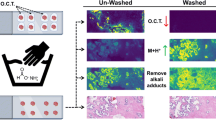Abstract
There is a high analytical demand for improving the detection sensitivity for various peptides in matrix-assisted laser desorption/ionization imaging mass spectrometry (MALDI-IMS) because exhaustive distribution analyses of various peptides could help to reveal the function of peptides in vivo. To improve the sensitivity of peptide detection, we used supercritical fluid of CO2 (scCO2) as washing solvent for a pretreatment to remove lipids. We evaluated whether our wash method using scCO2 with an entrainer improved the detection of peptides and suppressed lipid detection in MALDI-IMS. Our analysis revealed that the signal intensities of peptides such as m/z 3339.8, 3530.9, 4233.3, 4936.7, and 4963.7 were increased in scCO2-washed samples. The greatest improvement in the signal-to-noise ratio (S/N) was found at m/z 4963.7, which was identified as thymosin β4, with the S/N reaching almost 190-fold higher than the control. Additionally, all of the improved signals were associated with the morphologic structure. Our method allows us to analyze the distribution of molecules, especially in the region of m/z 3000–5200. For these improvements, the polarity difference between scCO2 and the matrix solution used was considered as a key. A wider variety of molecules can be analyzed in the future due to this improvement of the detection sensitivity by optimizing the polarity of scCO2 with various entrainers.

Mass spectra of m/z 4900-5000 obtained from a scCO2-washed tissue (upper, blue) and a control tissue (lower, red). Ion distribution of the signals at m/z 4936.7 and m/z 4963.7 specifically ditected from scCO2-washed samples


Similar content being viewed by others
References
Morgat C, Mishra AK, Varshney R, Allard M, Fernandez P, Hindié E. Targeting neuropeptide receptors for cancer imaging and therapy: perspectives with bombesin, neurotensin, and neuropeptide-Y receptors. J Nucl Med. 2014;55:1650–7.
Dumont Y, Bastianetto S, Duranton A, Breton L, Quirion R. Immunohistochemical distribution of neuropeptide Y, peptide YY, pancreatic polypeptide-like immunoreactivity, and their receptors in the epidermal skin of healthy women. Peptides. 2015;70:7–16.
OuYang C, Liang Z, Li L. Mass spectrometric analysis of spatio-temporal dynamics of crustacean neuropeptides. Biochim Biophys Acta. 2015;1854:798–811.
Kamei N, Morishita M, Kanayama Y, Hasegawa K, Nishimura M, Hayashinaka E, et al. Molecular imaging analysis of intestinal insulin absorption boosted by cell-penetrating peptides by using positron emission tomography. J Control Release. 2010;146:16–22.
Gerfen CR, Sawchenko PE. An anterograde neuroanatomical tracing method that shows the detailed morphology of neurons, their axons and terminals: immunohistochemical localization of an axonally transported plant lectin, Phaseolus vulgaris-leucoagglutinin (PHA-L). Brain Res. 2016;1645:42–5.
Hanrieder J, Malmberg P, Ewing AG. Spatial neuroproteomics using imaging mass spectrometry. BBA–Proteins Proteomics. 2015;1854:718–31.
Goodwin RJA, Pennington SR, Pitt AR. Protein and peptides in pictures: imaging with MALDI mass spectrometry. Proteomics. 2008;8:3785–800.
Lemaire R, Wisztorski M, Desmons A, Tabet JC, Day R, Salzet M, et al. MALDI-MS direct tissue analysis of proteins: improving signal sensitivity using organic treatments. Anal Chem. 2006;78:7145–53.
Seeley EH, Oppenheimer SR, Mi D, Chaurand P, Caprioli RM. Enhancement of protein sensitivity for MALDI imaging mass spectrometry after chemical treatment of tissue sections. J Am Soc Mass Spectrom. 2008;19:1069–77.
Lísa M, Holčapek M. High-throughput and comprehensive lipidomic analysis using ultrahigh-performance supercritical fluid chromatography-mass spectrometry. Anal Chem. 2015;87:7187–95.
Heidaryan E, Hatami T, Rahimi M, Moghadasi J. Viscosity of pure carbon dioxide at supercritical region: measurement and correlation approach. J Supercrit Fluids. 2011;56:144–51.
Sahena F, Zaidul ISM, Jinap S, Karim AA, Abbas KA, Norulaini NAN, et al. Application of supercritical CO2 in lipid extraction—a review. J Food Eng. 2009;95:240–53.
Huang Z, Shi XH, Jiang WJ. Theoretical models for supercritical fluid extraction. J Chromatogr A. 2012;1250:2–26.
Tanaka Y, Sakaki I, Ohkubo T. Extraction of phospholipids from salmon roe with supercritical carbon dioxide and an entrainer. J Oleo Sci. 2004;53:417–24.
Sugiura Y, Konishi Y, Zaima N, Kajihara S, Nakanishi H, Taguchi R, et al. Visualization of the cell-selective distribution of PUFA-containing phosphatidylcholines in mouse brain by imaging mass spectrometry. J Lipid Res. 2009;50:1776–88.
Spraggins JM, Rizzo DG, Moore JL, Rose KL, Hammer ND, Skaar EP, et al. MALDI FTICR IMS of intact proteins: using mass accuracy to link protein images with proteomics data. J Am Soc Mass Spectrom. 2015;26:974–85.
Cheng T, Zhao Y, Li X, Lin F, Xu Y, Zhang X, et al. Computation of octanol-water partition coefficients by guiding an additive model with knowledge. J Chem Inf Model. 2007;47:2140–8.
Kim S, Thiessen PA, Bolton EE, Chen J, Fu G, Gindulyte A, et al. PubChem substance and compound databases. Nucleic Acids Res. 2016;44:D1202–13.
Fricker DL. Analysis of mouse brain peptides using mass spectrometry-based peptidomics: implications for novel functions ranging from non-classical neuropeptides to microproteins. Mol BioSyst. 2010;6:1355–65.
Stoeckli M, Staab D, Staufenbiel M, Wiederhold K, Signor L. Molecular imaging of amyloid β peptides in mouse brain sections using mass spectrometry. Anal Biochem. 2002;311:33–9.
Acknowledgements
The authors thank S. Yamamoto and Y. Nakaya for their technical support with the scCO2 instrument. This work was supported by grants from Japan’s Ministry of Education, Culture, Sports, Science, and Technology (grant nos. 15H05900 and 15H05898B1), a Research Fellowship from the Japan Society for the Promotion of Science (JSPS KAKENHI grant no. JP16J05476), and a grant from Yamada Ryozo Kikin of the Hamamatsu Foundation for Science and Technology Promotion to M.S.
Author information
Authors and Affiliations
Corresponding author
Ethics declarations
Conflict of interest
The authors declare that they have no conflict of interest.
Electronic supplementary material
Below is the link to the electronic supplementary material.
ESM 1
(PDF 614 kb)
Rights and permissions
About this article
Cite this article
Matsushita, S., Masaki, N., Sato, K. et al. Selective improvement of peptides imaging on tissue by supercritical fluid wash of lipids for matrix-assisted laser desorption/ionization mass spectrometry. Anal Bioanal Chem 409, 1475–1480 (2017). https://doi.org/10.1007/s00216-016-0119-3
Received:
Revised:
Accepted:
Published:
Issue Date:
DOI: https://doi.org/10.1007/s00216-016-0119-3




